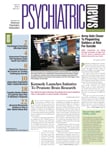An easy-to-use tool for evaluating civilly committed patients' risk of violence toward others after discharge from an acute psychiatric ward has been developed by Norwegian researchers.
The lead investigator was John Olav Roaldset, M.D., Ph.D., of the Norwegian University of Science and Technology, and the study results were reported in the March European Psychiatry.
The tool is called the V-RISK-10. It includes 10 questions that address previous or current acts of violence, threats of violence, substance abuse, and severe mental illness, as well as personality disorders, lack of insight into the illness or behavior, suspiciousness, lack of empathy, unrealistic planning, and whether the patient will be exposed to future stress situations.
The clinician using the tool needs to answer each of the questions on a four-point scale indicating the extent to which a factor is present in the patient: 1, when the answer is no or not present; 2, maybe or moderately present; 3, definitely present; and 4, don't know, too little information.
The researchers screened some 1,000 patients with the V-RISK-10 before the patients were discharged from an acute psychiatric ward and attempted to follow them over the subsequent year to see whether any of them committed acts of violence. They were able to follow up with about a third of them. (Many subjects were lost to follow-up because one of the research assistants left and was not replaced.)
An evaluation of 327 patients at the three-month follow-up showed that 69 (21 percent) had committed an act of violence, and an evaluation of 367 patients at the 12-month follow-up showed that 101 (28 percent) had. (Some of the patients missing in the three-month evaluation were located and included in the 12-month one, Roaldset explained to Psychiatric News.)
The researchers then tested the V-RISK-10's predictive value in their cohort. They found that it had an overall accuracy of 0.80 for any violent behavior at three months and an overall accuracy of 0.75 for any violent behavior at 12 months, and that held true for both male and female patients. The tool was even more accurate in predicting severe violence—0.87 at three months and 0.86 at 12 months.
"This study indicates that the V-RISK-10 is an easy-to-use, valid, and feasible tool for screening risk of violence in acute psychiatric patients," the researchers concluded. However, a challenge in using this tool, or any risk-assessment tool, they noted, "is the almost-inevitable inverse relationship between false negatives and false positives. In screening procedures, it is important to keep rates of false negatives as low as possible without having too many false positives…."
A leading forensic psychiatrist, Paul Appelbaum, M.D., a professor of psychiatry, medicine, and law at Columbia University and a former APA president, told Psychiatric News that the study is "interesting and promising."
"But the numbers of patients who were actually violent were small, and if one focuses on the group whose violence caused injury—the group of greatest public and policy concern—there were only seven at three months and 17 at 12 months. So although the results are promising, they were based on very small numbers and really need to be confirmed with larger samples," Appelbaum said.
In addition, that some tools for evaluating violence risk have been designed for forensic populations doesn't mean that they wouldn't also be helpful for civil ones, Appelbaum pointed out. The major predictors of violence that apply to people without mental illness—for example, past violence or substance abuse—also apply to those with it, he noted, and several tools for evaluating violence risk in forensic patients have already been tested on civil outpatients and found to be about as accurate as the V-RISK-10. "So it would be really helpful to have a comparative study to explore whether this instrument does better than the others or is about the same in its level of accuracy," he said.
The study was funded by the Norwegian University of Science and Technology, Alesund Hospital, and Oslo University Hospital.
